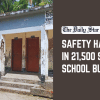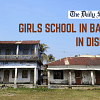Kurigram chars need high schools

With 70.8 percent of its population poor and 53.2 percent extremely poor, Kurigram is inarguably the face of poverty in Bangladesh. This district that is often in the news for sufferings caused by repeated flooding, riverbank erosion, and lack of work has been a rude reality check on Bangladesh's vaunted economic success. In addition, a large segment of its population is either illiterate or deprived of the opportunity to get into formal education. That being the case, we wonder, how can the government lift the district out of poverty?
As per a report by Prothom Alo, the situation is particularly dire in the char areas with little access to secondary education. About 16 rivers, big and small, flow through Kurigram, connecting over 400 chars – where about 5 lakh people of the district's 24 lakh population live. For this routinely battered and displaced community, there are only five high schools. Five for five lakh – a stark contrast to the government policy of allowing for a school at a distance of every three kilometres. Even if we include primary schools – about 169, according to the district primary education office – and madrasas, it doesn't come close to a satisfactory number.

As a result, most char students cannot go beyond primary education. Many boys end up in manual labour (farming/etc.) and many girls in early marriage. For the girls, "drop-out", so often the cause of early marriage in other districts, is not a word you would associate with them as there is hardly any secondary or lower secondary school there to drop out of. It presents them with an insurmountable challenge with far-reaching consequences. Reportedly, the few students that can manage to attend high schools have to do so by covering long distances, meaning extra costs, extra pressure (because of security and other concerns), and extra time spent in commuting (by boats).
It is, therefore, vital that the government takes urgent steps to improve access to education in these char areas. Experts say that, given the population size, there should be at least one primary school in every char and one high school for several nearby chars in Kurigram. There should also be supporting infrastructure and conditions for students to increase their access to secondary and higher education, including improved communications for commuting students, improved security for girl students, more stipends and education benefits, MPO status for schools, providing better incentives to households, and raising awareness of the vital role that proper education can play in eradicating poverty.
Char areas face some unique development challenges that may always remain, including the erratic weather and their vulnerability to rivers. But we need to give students the opportunity to dream big and explore their full potential. With the skills and aspirations thus acquired, they can do what the government's short-term employment/skills programmes cannot: elevate the socioeconomic status of this perennially poor region and help people better adapt to their vulnerabilities. Also, the lack of policy focus on the development of the district in general must be reversed.

 For all latest news, follow The Daily Star's Google News channel.
For all latest news, follow The Daily Star's Google News channel. 








Comments